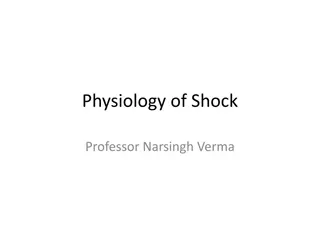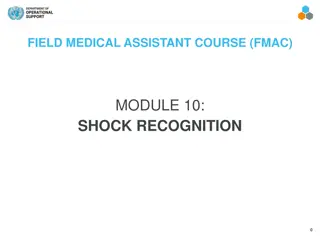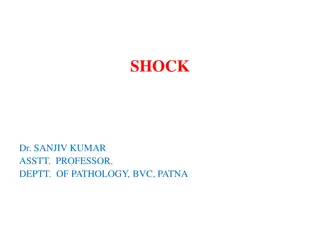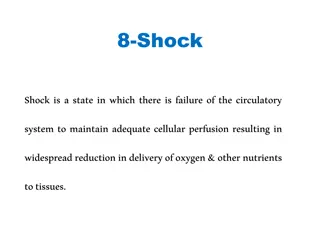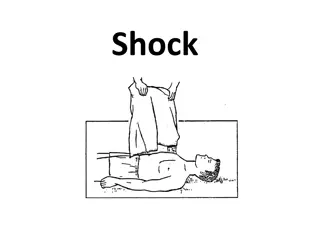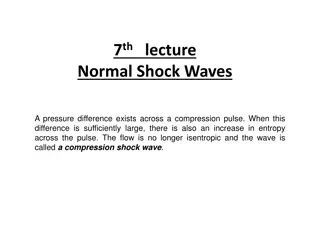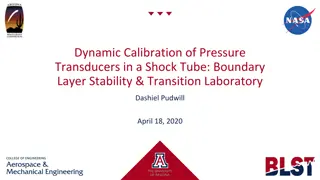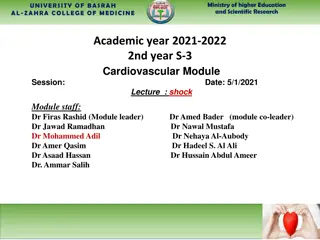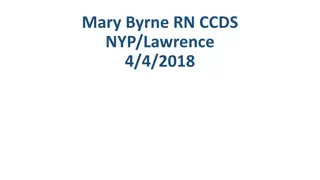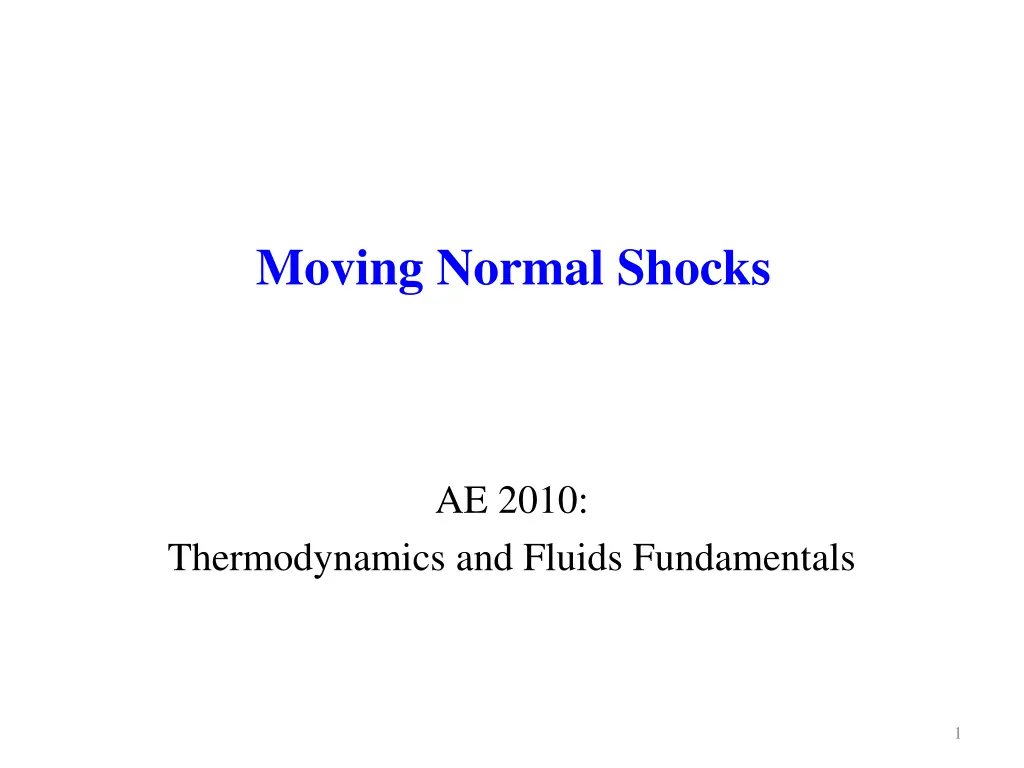
Understanding Moving Shock Waves in Thermodynamics
Explore the principles of moving shock waves in thermodynamics and fluids, including coordinate transformations and shock property ratios. Learn about analyzing known shock speeds and solving problems related to temperature and gas velocity changes.
Download Presentation

Please find below an Image/Link to download the presentation.
The content on the website is provided AS IS for your information and personal use only. It may not be sold, licensed, or shared on other websites without obtaining consent from the author. If you encounter any issues during the download, it is possible that the publisher has removed the file from their server.
You are allowed to download the files provided on this website for personal or commercial use, subject to the condition that they are used lawfully. All files are the property of their respective owners.
The content on the website is provided AS IS for your information and personal use only. It may not be sold, licensed, or shared on other websites without obtaining consent from the author.
E N D
Presentation Transcript
Moving Normal Shocks AE 2010: Thermodynamics and Fluids Fundamentals 1
Moving Normal Shocks v1 p1 1 T1 v2 p2 2 T2 So far, considered changes across shock wave for the case of the shock not moving Observer sitting on the shock, moving with shock What happens to properties if we consider the shock to be moving Observer not moving at same speed as shock 1 2 2
Coordinate Transformation First, convert moving shock to stationary shock Galilean transform Switch directions (+) and add shock speed, vs vi vs vg v1=vs-vi v2=vs-vg transform vs-vs=0 + + Now shock problem looks same as stationary (steady) problem that we already solved 3
Shock Property Ratios vi vs vg v1=vs-vi v2=vs-vg transform Static properties Property you would measure if moving with flow So, unaffected by transformation e.g., still use 2 T T 2 1 1 1 1 1 a 1 + 2 1 1 M 2 = 1 + 2 2 1 M 1 v 2 = = RT T = ; ; with M a T i Stagnation properties Depend on velocity; not same after transform Find using static properties and Mi, Mg, 4
Example: Known Shock Speed Given: Normal shock moving at 520 m/s into still air (300 K, 1 atm) vs=520 m/s Ti=300 K pi= 1 atm vg Tg Tog Toi Find: Temperature behind shock (after shock passes) Velocity of gas behind shock (in lab reference frame) Stagnation temperature before and after shock (in lab reference frame) Assume: air TPG/CPG with =1.4 5
Solution: Known Shock Speed Analysis: Transform to stationary shock vs=520 m/s v1=vs v2=vs-vg vg Ti=300 K pi= 1 atm Toi T2 transform Tg Tog find M1 in stationary frame v v v 520 1 1 1 = = = = . 1 = M 50 1 a 20 T 20 T 20 300 1 1 i M2 from Table or 2 2 2 1 2 1 = + = M M M 1 . 0 70 2 1 1 6
Solution: Known Shock Speed vs=520 m/s Analysis (con t): v1=vs v2=vs-vg vg Ti=300 K pi= 1 atm Toi T2 Tg Tog transform T2 from Table or T T 2 g = 4 . 1 + 1 4 . 1 + 1 2 2 = = 300 K 1 5 . 1 1 7 . 0 396 K 2 2 vg from Table or v v g = Toi, Tog T T o = v M T 2 2 2 = = = v v 1 v 1 241 m/s s 2 s s v M T 1 1 1 ( ( 1005 2 ) 2 2 241 m/s v = + = + = T 396 K 425 K ; T 300 K ; ) og oi J/kgK 2 c p To not same for moving shock 7
Example: Known Postshock Pressure Given: supersonic projectile (or equivalently piston) pushing gas ahead in tube filled with initially still air Leading shock produced P2 measured T1=294 K p1= 101.3 kPa vi=0 vp vs vg= T2 Find: in lab ref. frame Shock speed (vs) Projectile speed (vp) Assume: Air TPG/CPG with =1.4 p2=608 kPa 8
Solution: Known Postshock Pressure Analysis: Transform to stationary shock vs vg= vp v1=vs v2=vs-vp T1=294 K, T2 use p information transform p 608 in shock s ref. frame, subsonic behind shock 2 = = = = M . 2 30 , M . 0 534 . 6 00 1 2 p 101 3 . 1 ( ) = = = = v v a M 1 20 294 m/s 2.3 789 m/s s 1 1 From table . 1 = . 1 = K = = = T T 294 ( 947 ) = v v v v a M v 20 T M 2 p s 2 s 2 2 s 2 2 1 T2 947 572 K = = vp 789 20 572 . 0 ( 534 ) m/s 533m/s v 533 m s p in lab reference frame, supersonic behind shock = = . 1 = M 12 g a 20 572 m s 2 9
Example: Postshock Speed Known Given: Normal shock moving into still gas (at T1) produces known gas speed (vg) behind shock vs vg vi=0 T1 Find: Expression for shock speed vs in terms of vg Assume: TPG/CPG 10
Solution: Postshock Speed Known Analysis: In stationary ref. frame v1=vs v2=vs-vg velocity ratio T1 1 1 1 + 2 2 + 1 M ( ) 2 1 + 2 2 + 2 M 2 1 1 v M T M M 2 1 1 1 1 = = = = = ... ( ) 1 1 1 v M T M 1 M 2 2 1 + + 2 2 2 2 1 M 2 1 2 2 M another normal shock relation 0 a = )( v ) ( 2 + + v v a 1 1 2 s 2 s s 1 = v v v g s ( )( ) 2 2 v v + 1 a 2 s g s 1 2 + + 1 1 1 2 g = + + RT v v v 4 s g 1 4 2 2 11
Numerical Example: Known vg Given: Piston impulsively set into motion at 400 m/s in 25 cm2 tube filled with initially still air at 290 K, 100 kPa Leading shock produced T1=290 K p1=100 kPa vi=0 vp Ms vg= vp= 400 m/s p2 Find: Mach number of shock, Ms (relative to unshocked gas) Force, Fp, required to keep piston moving Assume: air TPG/CPG with =1.4, no friction on piston 12
Solution: Known vg Analysis: Transform to stationary shock vs vg= vp v1=vs v2=vs-vp T1=290 K p1=100 kPa p2 transform use result from pre. example 1 v = 2 + + 1 1 2 g + + RT v v 4 + s g 1 4 2 2 ( ) 1 ( ) ( ) 2+ 2 2 6 . 0 = 400 m s . 1 44 400 m s 6 . 5 287 m s K 290 K 2 = = . 1 = vs= M v a 657 ( 4 . 1 287 ) 290 93 6 57 m/s s s 1 M1=Ms (vi=0) F = p A = p p . 4 18 p 2 p ( . 0 ) 2 1 2= = >235 lbf required to move 2.2 inch diam. piston w/o friction 418 kPa 0025 m 1045 N p2= 418 kPa 13






